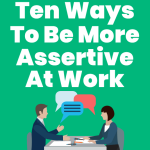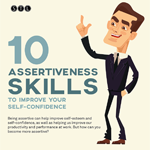98.7% Of all customers recommend us, we're so confident about our results we publish all reviews and stats
View Live Stats View Reviews
 Building Confidence and Assertiveness Training at Work
Building Confidence and Assertiveness Training at Work
Assertiveness Training London and UK wide
Face to face / Online public schedule & onsite training. Restaurant lunch included at STL venues.
| (220 reviews, see all 99,474 testimonials) |
From £379 List price £650
- 1 day Instructor-led workshop
- Courses never cancelled
- Restaurant lunch
Syllabus
Who is this course for?
This Assertiveness Training course is for people who want to build confident and robust working relationships with colleagues and customers.
In particular it will provide the tools to distinguish submissive, aggressive and assertive behaviour and to respond appropriately.
Other relevant courses include:
problem solving training or emotional intelligence in the workplace training courses.

Benefits
At the end of this practical course delegates will be equipped with relevant assertiveness communication skills to handle potentially tricky situations such as giving and receiving feedback, and saying "No" whilst staying focused.Course Syllabus
Assertiveness in context
The Assertiveness Triangle
Passive / Aggressive characteristics
What is Assertive communication?
Triggers and responses
Cause and effect
Levels of assertiveness
Assertiveness and us
Our assertive rights
Your inner dialogue
Body language, tone, words and appearance
Reframing language
Assertiveness and Confidence
What is confidence
Confidence myths debunked
Identifying when we lack confidence
Removing blockers to confidence
Knowing what to do when we lack confidence
Faking confidence when you don’t feel it
Dealing with manipulation
Assertiveness Strategies/Tools
Assertiveness Strategies/Tools
Levels of assertion
Delivering assertive messages
Saying ‘No’
The ‘DESC’ assertive script technique
Prices & Dates
What you get
"What do I get on the day?"
Arguably, the most experienced and highest motivated trainers.
Face-to-face training
Training is held in our modern, comfortable, air-conditioned suites.
Lunch, breaks and timing
A hot lunch is provided at local restaurants near our venues:
- Bloomsbury
- Limehouse
Courses start at 9:30am.
Please aim to be with us for 9:15am.
Browse the sample menus and view joining information (how to get to our venues).
Refreshments
Available throughout the day:
- Hot beverages
- Clean, filtered water
- Biscuits
Online training
Regular breaks throughout the day.
Learning tools
In-course handbook
Contains unit objectives, exercises and space to write notes
24 months access to trainers
Your questions answered on our support forum.
Training formats & Services
Training Formats & Services
|
Testimonials
STL

Kamm Bachu,
SBDM
Excellent course
Building Confidence and Assertiveness at Work
ABC International Bank

Karen Davies,
Project Manager
Alison was fantastic. She was asked to condense a full day's course into just 1 hour. She kept the delivery high level and fast paced and engaged all the participants. Thank you Alison.
Building Confidence and Assertiveness at Work
Maps Medical Reporting

Ajay Bhatt,
Experts Relationship Junior
Things were done right.
Building Confidence and Assertiveness at Work
Learning & Development Resources
Soft Skills Blog
- How to be Assertive (not annoying!) at work
- Building Confidence And Assertiveness at Work
- Powerful tips to be more naturally assertive at work
- Assertiveness Simplified
- How to be Assertive with Senior Managers and Clients
- Confidence without a Parachute. Choice or practice?
- Embodying Confidence - Even when you don’t feel it
- Speak Up with Confidence: Guide to Assertive Communication
- Powerful tips to be more naturally assertive at work
Infographics
Training manual sample
Below are some extracts from our Building Confidence and Assertiveness at Work manual.
Assertiveness at Work (extract from our Assertiveness Training Course)
An assertive person is confident and direct in dealing with others. Assertive communications promote fairness and equality in human interactions, based on a positive sense of respect for self and others. It is the direct communication of a person’s needs, wants, and opinions without punishing, threatening, or putting down another person.
Assertive behaviour includes the ability to stand up for a person’s legitimate rights – without violating the rights of others or being overly fearful in the process. A skill that can be learned, assertive behaviour is situationally specific; meaning different types of assertive behaviour can be used in different situations.
Assertive behaviour involves three categories of skills; self-affirmation, expressing positive feelings, and expressing negative feelings. Each will be explored during this course.
Self-confidence is a belief in oneself, one's abilities, or one's judgment. It is freedom from doubt. Learning how to be assertive at work can help you believe you can change things -- or make a difference in a situation, you are much more likely to succeed.
As a self-confident person, you walk with a bounce in your step. You can control your thoughts and emotions and influence others. You are more prepared to tackle everyday challenges and recover from setbacks. This all leads to a greater degree of optimism and life satisfaction.
There are four styles of communication: Passive, aggressive, passive-aggressive, and assertive.
The Passive Person
Passive behaviour is the avoidance of the expression of opinions or feelings, protecting one’s rights, and identifying and meeting one’s needs. Passive individuals exhibit poor eye contact and slumped body posture, and tend to speak softly or apologetically. Passives express statements implying that:
“I’m unable to stand up for my rights.”
“I don’t know what my rights are.”
“I get stepped on by everyone.'
“I’m weak and unable to take care of myself.”
“People never consider my feelings.”
The Aggressive Person
An aggressive individual communicates in a way that violates the rights of others. Thus, aggressive communicators are verbally or physically abusive, or both. Aggressive communication is born of low self-esteem, often caused by past physical or emotional abuse, unhealed emotional wounds, and feelings of powerlessness.
Aggressive people display a low tolerance for frustration, use humiliation, interrupt frequently, and use criticism or blame to attack others. They use piercing eye contact and are not good listeners. Aggressive people express statements implying that:
The other person is inferior, wrong, and not worth anything
The problem is the other person’s fault
They are superior and right
They will get their way regardless of the consequences
They are entitled, and that the other person “owes” them.
The Passive-Aggressive Person
The passive-aggressive person uses a communication style in which the individual appears passive on the surface but is really acting out anger in a subtle, indirect, or behind-the-scenes way.
Passive-aggressive people usually feel powerless, stuck, and resentful. Alienated from others, they feel incapable of dealing directly with the object of their resentments. Rather, they express their anger by subtly undermining the real or imagined object of their resentments. Frequently they mutter to themselves instead of confronting another person. They often smile at you, even though they are angry, use subtle sabotage, or speak with sarcasm.
Passive-aggressive individuals use communication that implies:
“I’m weak and resentful, so I sabotage, frustrate, and disrupt.”
“I’m powerless to deal with you head on so I must use guerilla warfare.”
“I will appear cooperative, but I’m not.”
The Assertive Person
An assertive individual communicates in a way that clearly states his or her opinions and feelings, and firmly advocates for his or her rights and needs without violating the rights of others. Assertive communication is born of high self-esteem. Assertive people value themselves, their time, and their emotional, spiritual, and physical needs. They are strong advocates for themselves -- while being very respectful of the rights of others.
Assertive people feel connected to other people. They make statements of needs and feelings clearly, appropriately, and respectfully. Feeling in control of themselves, they speak in calm and clear tones, are good listeners, and maintain good eye contact. They create a respectful environment for others, and do not allow others to abuse or manipulate them.
The assertive person uses statements that imply:
“I am confident about who I am.”
“I cannot control others, but I control myself.”
“I speak clearly, honestly, and to the point.”
“I know I have choices in my life, and I consider my options. I am fully responsible for my own happiness.”
“We are equally entitled to express ourselves respectfully to one another.”
A person who has a strong sense of personal worth makes a confident, positive appearance.
In the dictionary, appearance is defined as an external show, or outward aspect. Your confidence depends significantly on your personal thoughts and perceptions about the way you look.
Body language is a form of non-verbal communication involving the use of stylized gestures, postures, and physiologic signs which act as cues to other people. Humans unconsciously send and receive non-verbal signals through body language all the time.
One study at UCLA found that up to 93% of communication effectiveness is determined by nonverbal cues. Another study indicated that the impact of a performance was determined 7% by the words used, 38% by voice quality, and 55% by non-verbal communication. Your body language must match the words used. If a conflict arises between your words and your body language, your body language governs. The components of body language include:
Eye contact. The impact of your message is affected by the amount of eye contact you maintain with the person with whom you are speaking. One who makes eye contact is normally perceived as more favourable and confident.
Posture. Find comfortable sitting and standing postures that work for you; avoid any rigid or slouching positions.
Excessive or unrelated head, facial, hand and body Movement. Too much movement can divert attention from the verbal message. Your facial expressions should match the type of statement you are making; smile when saying “I like you”, and frowning when saying “I am annoyed with you”. Occasional gestures that reinforce your verbal message are acceptable.
It takes as few as seven seconds – and no more than thirty seconds -- for someone to form a first impression about you. Like it or not, people make judgments about others right away based on a presenting appearance. And you never have a second chance to make a first impression. Below are some tips to help you make that positive first impression when someone.
· Body language. Remember that body language makes up to 55% of a communication.
· Dress and grooming. It's less about your budget, and more about clean, pressed and event-appropriate clothing with neat grooming.
· Handshake. Use a medium to firm handshake grip, avoiding a week, one handshake or overly firm one that can cause potential discomfort to another.
· Body Movement. Use a mirror, or enlist the help of a friend to make sure that your movements are not overly active --and that they support the nature of your message.
Feeling and looking the part would not be complete without the voice. Given that we know that 38% of communication effectiveness is governed by voice quality, improving your overall voice message delivery is worthwhile.
We are all born with a particular tone of voice, which we can learn to improve. The goal is to sound upbeat, warm, under control, and clear. Here are some tips to help you begin the process.
1. Breathe from your diaphragm
2. Drink plenty of water to stay hydrated; avoid caffeine because of its diuretic effects
3. Posture affects breathing, and also the tone of voice, so be sure to stand up straight
4. To warm up the tone of your voice, smile
5. If you have a voice that is particularly high or low, exercise it’s by practising speaking on a sliding scale. You can also sing to expand the range of your voice.
6. Record your voice and listen to the playback
7. Deeper voices are more credible than higher pitched voices. Try speaking in a slightly lower octave. It will take some practice, but with a payoff, just as radio personalities have learned
8. Enlist a colleague or family member to get feedback about the tone of your voice.
**ASSERTIVENESS SKILLS TO IMPROVE YOUR SELF-CONFIDENCE**
(taken from our popular Infographic - Ten Assertiveness Skills To Improve Confidence, itself compiled by our trainers experiences of delivering Assertiveness Training courses.)
Being assertive can have a positive impact on self-esteem, self-confidence, productivity, and performance at work. Here are some tips on how to become more assertive:
**1. Be Aware of Your Posture**
Your posture and body language play a crucial role in how confident you feel and how others perceive you. Maintaining an upright posture and lifting your chin can make you appear more assertive and naturally boost your confidence.
**2. Maintain Eye Contact**
Eye contact is essential for establishing trust and respect in interpersonal interactions. Practicing good eye contact when speaking to someone can make them feel heard and encourage active listening.
**3. Use the 'Fogging' Technique**
The fogging technique involves agreeing with the other person without allowing their comments to bother you. Treating criticism as feedback and not taking it personally can help diffuse verbal criticism and project calmness, rationality, and confidence.
**4. Positive Enquiry**
When receiving compliments, it can be challenging for non-assertive individuals to respond appropriately. Practicing positive enquiry involves thanking the person and agreeing with the compliment while asking for specific details about what they liked.
**5. Maintain Your Personal Space**
Manipulative or aggressive individuals often invade personal space to establish dominance. Being assertive means maintaining boundaries by physically stepping back or requesting that others respect your personal space.
**6. Disclosure**
Non-assertive people tend to avoid disclosing information that could make their lives easier. Sharing relevant personal information, such as hearing difficulties or food preferences, can contribute to improved situations and assertiveness.
**7. Active Listening**
Active listening is a crucial skill for assertiveness. Show others that you are attentive by maintaining eye contact, using non-verbal cues like nodding, asking relevant questions, and briefly summarizing what others have said to demonstrate understanding.
**8. Repeat Yourself**
Repeating your needs or preferences calmly and clearly, often referred to as the 'broken record' technique, can help assert yourself in situations with unfamiliar individuals, such as cold callers or salespeople.
**9. Notice Your Tone of Voice**
The way you speak, including tone, volume, pitch, and speed, greatly influences how you are perceived. Speaking slowly, clearly, and at a lower pitch can help convey confidence, especially in stressful situations.
**10. Value Your Time**
Assertive individuals value their own time and respect the time of others. Communicate your expectations clearly if someone consistently wastes or devalues your time. Similarly, ensure you are respectful of other people's time by being punctual and reliable.
**Summary:**
Developing assertiveness skills can greatly benefit business workers, both in their professional and personal lives. By becoming more assertive, individuals can improve their self-confidence, which positively impacts their interactions with colleagues, clients, and superiors.
Assertiveness allows individuals to express their opinions and needs effectively, leading to better communication, increased productivity, and improved working relationships. Furthermore, assertiveness skills can translate into personal life, empowering individuals to set boundaries, handle conflicts, and advocate for themselves effectively.
Overall, mastering assertiveness enhances individuals' well-being, satisfaction, and success in various aspects of life. STL our proud to help people master these skills with a range of courses that include Assertiveness Training.
Thanks. Your download will begin shortly.
Please help us
Share or create a link to this manual today!
Just follow these simple instructions...










